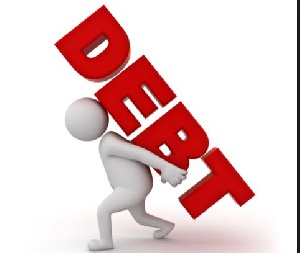Summary of economic and financial data by the Bank of Ghana has put Ghana’s total debt stock as at the end September this year at GH¢138.9 billion. This represents 68.6% of Gross Domestic Products (GDP).
Domestic debts accounted for GH¢63.3 billion, representing 31.3% of GDP, while external stood at GH¢75.5 billion, the equivalent of $17.2 billion, representing 37.4 of GDP.
Total public debt stock as at the end of 2016 was GH¢122.6 billion. This means that between January and September 2017, the government has added GH¢16.3 billion to the public debt stock.
Interest cost and deficit financing to blame
Analysts explained that the increase in the public debt stock was the result of deficit financing and payment of inherited arrears and debts.
Government borrowed more than GH¢16.3 billion in the first nine months of 2017, but the debt stock did not go up to equal the amount borrowed because part of the money borrowed was used to pay off part of the country’s debt.
GH¢27.3 as interest cost and deficit financing for 2017
Projected interest cost and deficit financing for 2017 amount to GH¢27.3 billion.
End of 2016 budget deficit was 9%, but the new government projected to reduce it 6.5% by the end of this year.
The 6.5% projected budget deficit for 2017 represents GH¢13.2 billion as the difference between the government’s revenue expectations for 2017 compared to the expenditure targets for the period.
Government’s total revenue target for 2017 is estimated at GH¢44.9 billion against a targeted expenditure of GH¢58.1 billion, representing 28.6% of GDP.
How the deficit is being financed
Government revealed that the deficit will be financed by domestic and international sources.
Net domestic financing will amount to GH¢14.6 billion, equivalent to 7.1% of GDP while foreign financing is expected to reach GH¢1.3 billion, representing 0.6% of GDP.
Government’s borrowing plan for 2017
Government is hoping to raise some GH¢72 billion through bonds and Treasury bills by December this year.
How other sectors fared according to the data
The data showed that Ghana’s earnings from exports witnessed some significant growth. It reached $10.2 billion in October this year.
This actually represents a little over $2 billion increase, compared to the $8 billion secured for the same period in 2016. Revenue from Ghana’s top three exports are gold - $4.3 billion, cocoa - $2 billion, and crude oil - $1.9 billion.
However, on the import side, Ghana ended the month of October spending $9.3 billion to finance oil and other goods. This resulted in a trade balance of $708 million.
The country’s international reserves as at October 31, 2017, stood at $6.9 billion, representing 3.9 months of import cover reserves.
Banking sector developments
Commercial banks in the country were still struggling to recover loans that they fear might go bad as the data puts the percentage of industry Non Performing Loans (NPL) ending October at 21.6 percent, up from the 19 per cent for the same period.
Despite this challenge, total banking assets for the first 10 months of this year reached ¢88.9 billion compared to ¢73.8 billion for the same period for last year.
Loan advances also stood at ¢38 billion ending October this year. Despite the increases in the actual amount, real annual growth slowed compared to the same period for last year.
Business News of Monday, 27 November 2017
Source: thefinderonline.com

















